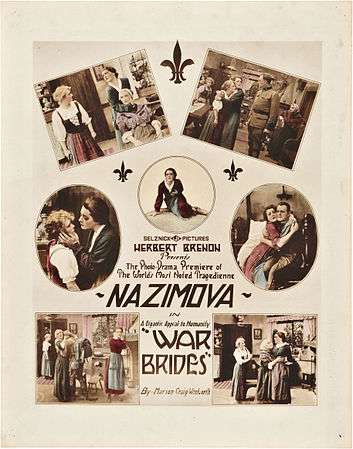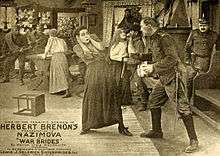War Brides (film)
| War Brides | |
|---|---|
 Theatrical poster | |
| Directed by | Herbert Brenon |
| Produced by | Herbert Brenon |
| Written by | Herbert Brenon (scenario) |
| Based on |
War Brides (play) by Marion Craig Wentworth |
| Starring |
Nazimova Charles Bryant |
| Music by | Robert Hood Bowers |
| Cinematography | J. Roy Hunt |
| Edited by | James MacKaye |
| Distributed by | Selznick Pictures |
Release date | November 12, 1916 |
Running time | 72 minutes |
| Country | United States |
| Language | Silent (English intertitles) |
| Box office | $300,000[1] |

War Brides is a lost[2] 1916 American silent war drama film directed by Herbert Brenon and starring Alla Nazimova. The film marked Nazimova's debut in motion pictures.[3][4]
The film's lost status makes it a sought-after title.
Plot
The film was based on the eponymous one-act play by the poet, playwright, and suffragist Marion Craig Wentworth (1872-1942).[5] A newlywed soldier is sent to the front and killed. When his young widow learns of his death she considers committing suicide, but decides against it because she is pregnant. The King of her country (unnamed in the original; Germany in the later version) decrees that women must bear more children to fight in future wars. Soon afterwards, as the King is passing through her village, the pregnant widow leads a procession of women to protest the war. Soldiers try to hold her back, but she manages to come face to face with the King, and kills herself in front of him. The title card reads, "If you will not give us women the right to vote for or against war, I shall not bear a child for such a country!"[6]
Cast
- Alla Nazimova - Joan
- Charles Hutchison - George
- Charles Bryant - Franz
- William Bailey - Eric
- Richard Barthelmess - Arno
- Nila Mac - Amelia (*Nila Mack)
- Gertrude Berkeley - The Mother
- Alex Shannon - The King
- Robert Whitworth - Lt. Hoffman
- Ned Burton - Captain Bragg
- Theodora Warfield - Minna
- Charles Chailles - A Financier
Reception
War Brides was one of the most successful plays of 1915.[7] It opened in January at B.F. Keith's Palace Theatre in New York City, with Alla Nazimova in the lead role, and toured the country for several months. The play was so much in demand that a second production toured the South, with Gilda Varesi in the lead.[8]
In 1916 it was made into a silent film, also starring Nazimova in her first onscreen role. The film did very well in the United States, bringing the studios a profit of $300,000, and was widely acclaimed by critics. Because of its pacifist message, it was banned in some cities and states. In 1917 it was withdrawn from circulation on the grounds that "The philosophy of this picture is so easily misunderstood by unthinking people". Later that year the producer, Lewis Selznick, had the film edited to give it an anti-German slant, and re-released it to American theaters.[6] It was not shown in any other Allied countries.[8]
References
- ↑ Terry Ramsaye (January 1925). "The Romantic History of the Motion Picture". Photoplay. p. 120.
- ↑ The Library of Congress American Silent Feature Film Survival Catalog: War Brides
- ↑ Progressive Silent Film List: War Brides at silentera.com
- ↑ The AFI Catalog of Feature Films: War Brides
- ↑ Sutphen, Joyce (2006). To Sing Along the Way: Minnesota Women Poets from Pre-Territorial Days to the Present. New Rivers Press. p. 232.
- 1 2 Hollander, Neil (2013). Elusive Dove: The Search for Peace During World War I. McFarland. p. 213. ISBN 9780786478910.
- ↑ Tylee, Claire M. (1995). "The Great War in Modern Memory: What is Being Repressed?". 4 (4): 65–77. JSTOR 40003501.
- 1 2 Cardinal, Agnes; Turner, Elaine; Tylee, Claire M. (2013). War Plays by Women: An International Anthology. Routledge. p. 13. ISBN 9781136357251.
Further reading
- Wentworth, Marion Craig (1915). War Brides: A Play in One Act. Century Company.
External links
| Wikimedia Commons has media related to War Brides (film). |